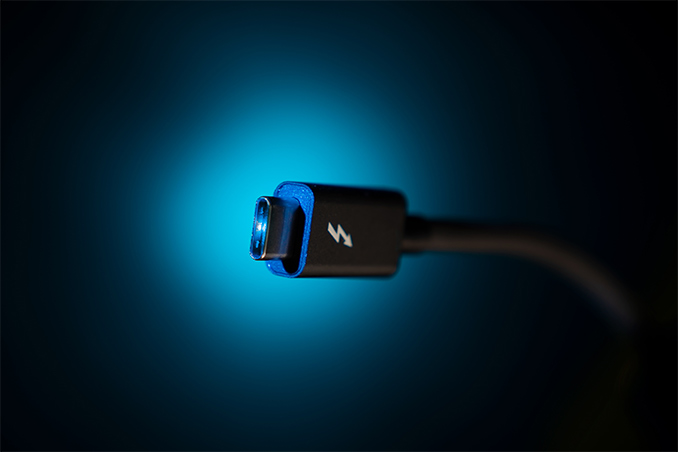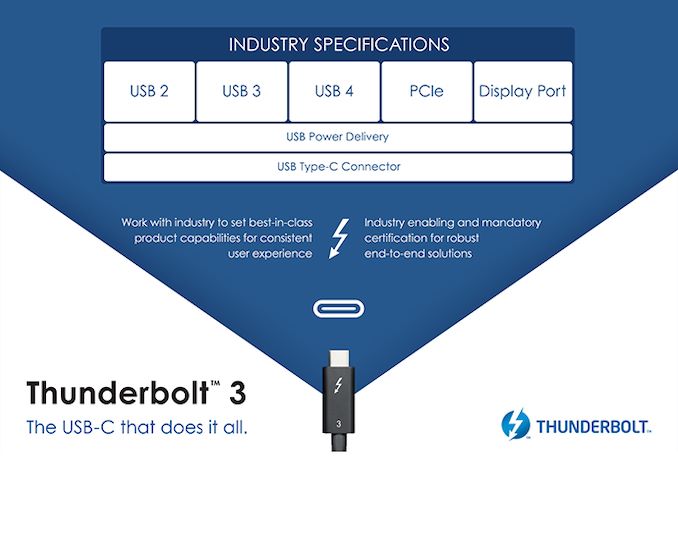USB4 Specification Announced: Adopting Thunderbolt 3 Protocol for 40 Gbps USB
by Anton Shilov on March 4, 2019 1:35 PM EST- Posted in
- Peripherals
- USB-C
- USB
- USB4

The USB Promoter Group has announced the upcoming release of the USB4 specification. The new standard is based on Intel’s Thunderbolt protocol and supports a range of features, including data transfer rates of up to 40 Gbps, display interfaces, and power delivery. The detailed USB4 specification will be published in the middle of 2019.
The USB4 specification will be based on the Thunderbolt protocol that Intel has contributed to the USB Promoter Group. The new interface will use USB Type-C connectors and will maintain backwards compatibility with USB 2.0, USB 3.2, and Thunderbolt 3 interfaces. The maximum data transfer rate supported by the new USB4 interface is 40 Gbps over 40 Gbps-certified cables. Also, USB4 will support various display protocols, and power delivery.
The USB4 standard will be officially ratified in the middle of 2019. At present over 50 companies are actively participating in the final stages of development of the draft USB4 specification.
Based on what we know about the USB4 specification at this point, the new standard will use the Thunderbolt protocol, but it will not be exactly Thunderbolt 3 as its functionality will likely be different.
| USB Specifications | ||||||||
| USB 1.0 | USB 2.0 | USB 3.2 Gen 1 | USB 3.2 Gen 2 |
USB 3.2 Gen 2x2 |
USB4 | |||
| Alternative Branding | - | High Speed | Super Speed |
Super Speed+ |
Super Speed+ |
? | ||
| Bandwidth | 12 Mbps | 480 Mbps | 5 Gbps | 10 Gbps | 20 Gbps | 40 Gbps | ||
| Encoding | 8b/10b | 128b/132b | ||||||
| Introduction | 1996 | 2001 | 2009 (USB 3.0) |
2014 (USB 3.1 Gen 2) |
2017 | 2019 | ||
The contribution of the Thunderbolt 3 protocol to the USB Promoter Group essentially brings TB3 to mainstream PC platforms and enables various companies to integrate its support into their products. Meanwhile, Intel’s Ice Lake processors will be the first CPUs to support Thunderbolt 3 natively.
“Releasing the Thunderbolt protocol specification is a significant milestone for making today’s simplest and most versatile port available to everyone,” said Jason Ziller, General Manager, Client Connectivity Division at Intel. “By collaborating with the USB Promoter Group, we’re opening the doors for innovation across a wide range of devices and increasing compatibility to deliver better experiences to consumers.”
Related Reading
- USB 3.2 at 20 Gb/s Coming to High-End Desktops This Year
- ASMedia Demos USB 3.2 Gen 2x2 PHY, USB 3.2 Controller Due in 2019
- USB 3.2 Update to Bring 20 Gbps Bandwidth: USB 3.1 Type-C Cables Compulsory
- Cosemi Launches USB 3.1 Gen 2 Hybrid Active Optical Cable: Up to 50 Meters of USB
- Cypress and Zhaoxin Have USB 3.1 Gen 2 USB Controllers
Sources: USB Promoter Group, Intel












56 Comments
View All Comments
HStewart - Monday, March 4, 2019 - link
"The new standard is based on Intel’s Thunderbolt protocol and supports a range of features, including data transfer rates of up to 40 Gbps, display interfaces, and power delivery. The detailed USB4 specification will be published in the middle of 2019."This sounds like USB4 is same as Thunderbolt 3 maybe with exception of possibly supporting USB 3.2 Gen 2x2 which may already work since TB3 surely can support 20Gbs
p1esk - Monday, March 4, 2019 - link
Can it make DP1.4 and HDMI 2.1 obsolete?HStewart - Monday, March 4, 2019 - link
Thunderbolt 3 does support DP1.4 not sure anything support HDMI 2.1jeremyshaw - Monday, March 4, 2019 - link
TB3 controllers already support DP1.4. Issue comes down to the ancient DP controller in Intel GPUs. Most TB3 setups (all?) do not hook a Nvidia or AMD GPU to the DP muxer in the TB3 controller.Midwayman - Monday, March 4, 2019 - link
Its not fast enough for hdmi 2.1 That's 48Gbps.Vitor - Wednesday, March 6, 2019 - link
No. HDMI 2.1 is 20% faster (48gbps)id4andrei - Monday, March 4, 2019 - link
Sounds like UBS is being hijacked by TB. TB should be an option and not the cornerstone of USB.Great_Scott - Monday, March 4, 2019 - link
Eh. If you can't beat them, join them. There's nothing inherently wrong with TB3 other that it being proprietary and expensive.Now it's just expensive, but hopefully the cost will come down in line with the increased usage.
Intel learned the lesson that IBM taught everyone - you can make something a profit center, or you can make something popular. But not both.
Rest in Peace, MCA adapters and Token Ring networking.
rrinker - Monday, March 4, 2019 - link
Hey, at the time, Token Ring had a great advantage over Ethernet - it was consistently slow. One station or 200, same speed, whereas in those pre-switch days, Ethernet was REALLY fast with only a couple of stations but keep adding more to the same collision domain and it got slower. And how can you hate on anything that had devices known as CAUs and LAMs? Who didn't want their data center to be a barnyard? I don;t even want to talk about the effort we had to go through to make a super neat and tidy patch panel with those giant connectors and heavy cable - and it had to be neat because they put the thing behind a glass wall with spotlights shining on it so management could show clients just how high tech we were! The actual high tech devices in the room, the servers themselves, were not visible through the glass wall.ANd also - inspiration for the single best Dilbert strip ever - where they get the PHB to crawl around on the floor of his office looking for the token that fell out when he unplugged his network cable.
Dolda2000 - Monday, March 4, 2019 - link
>There's nothing inherently wrong with TB3 other that it being proprietary and expensive.Well, except for it being PCIe and thus on the system bus. Access control for PCIe devices is tricky at best, and I quite fear that walking around with PCIe exploit dongles will be the Word-macro exploit of the 2020s. The nice thing with "traditional" USB is that it's a protocol that goes via the CPU and that can therefore be properly controlled in software.
Thunderbolt is nice and all, but I wonder if they really know what they're doing when they're putting easily accessible system-bus-expander ports on increasingly mobile systems.